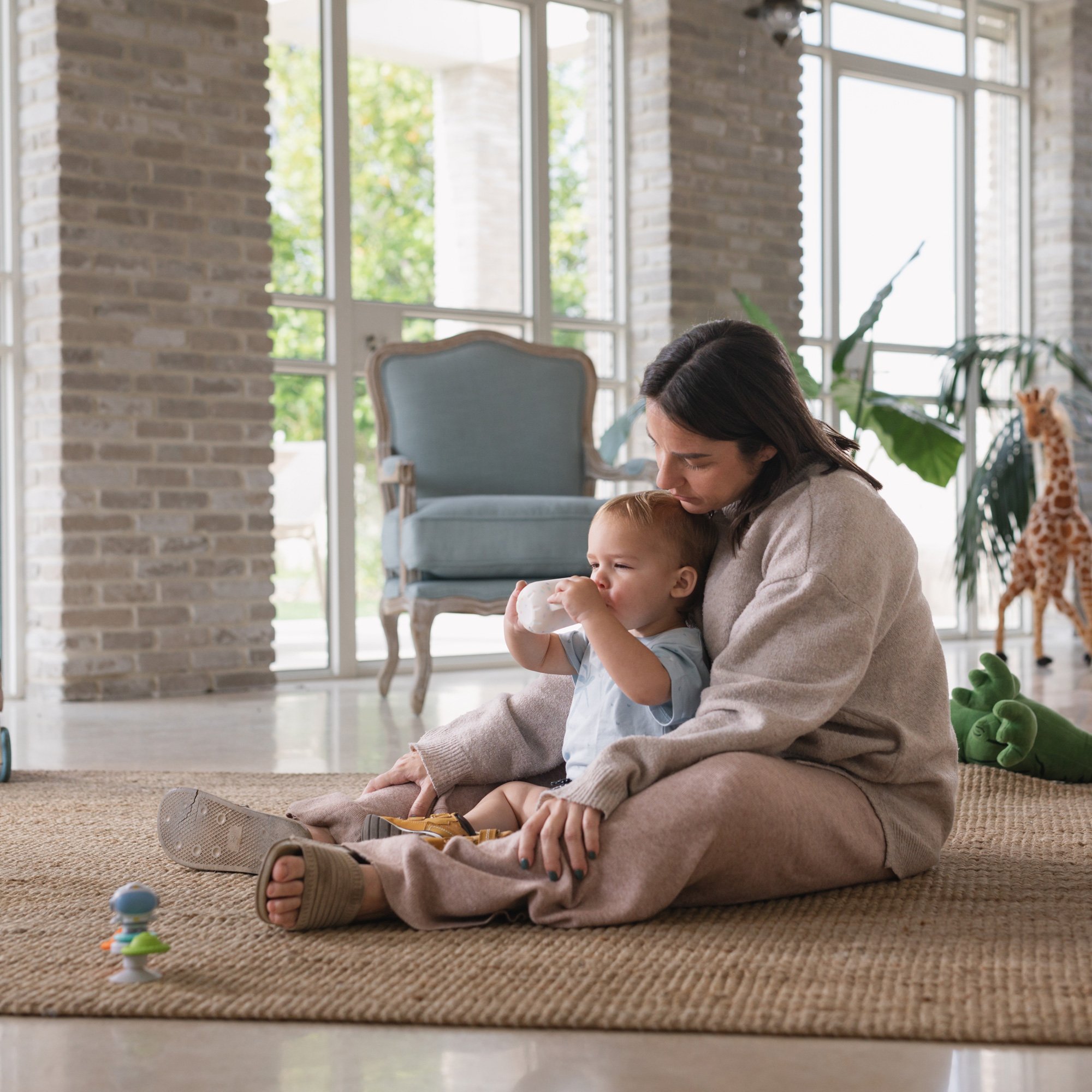How to Hold a Baby While Bottle Feeding
Knowing how to hold a baby while bottle feeding can ensure the experience is comfortable for both you and your little one.
This guide covers how to properly hold a baby while feeding a bottle. It offers information on techniques and tips and also includes common concerns.

Get Set Up for Bottle Feeding
Discover how to choose the right equipment and prepare your feeding area.
Choose the Right Bottle and Nipple
The first step is to get the most suitable bottle and nipple. For younger babies, choose a small-size bottle (5-6 oz/140-180 ml). Older babies can graduate to a larger size (8-9 oz/225-270 ml).
For a newborn or young baby, get a slow-flow nipple. As they grow, you can upgrade to nipples with faster flow.
You may also consider an anti-colic bottle to reduce air swallowing or a self-sterilizing bottle for easy cleaning.
Prepare the Feeding Area
Dedicate a quiet and comfortable area to feeding. Keep it at a suitable temperature — around 68 to 72 degrees Fahrenheit is recommended.
Equip your feeding area with these essentials:
- Comfortable chair;
- Nursing/pregnancy pillow to support your back;
- Drinks and snacks;
- Blanket;
- Cell phone and/or device to listen to music on;
- Muslin cloths;
- Diaper changing essentials;
- Night light or lamp.
How to Properly Hold a Baby While Bottle Feeding
Learn different holding techniques to help you bottle-feed.
The Best Holding Techniques
The best positions allow you to hold your baby upright or semi-upright. These positions reduce the risk of reflux, which can be distressing for your baby.
In the cradle position, you support your baby’s head in the crook of your elbow, holding them at a slight angle.
You can also try holding your baby in a seated position on your lap, with their head resting against your chest.
Another option is to sit with your knees bent and position your baby on your legs, with their spine against your thighs.

How to Hold a Newborn Baby While Bottle Feeding
The cradle position works well for newborn babies. Take care to support your baby’s head and neck with your arm — at this stage, their neck muscles are not developed and they cannot support themselves. Your hand can extend to support their bottom.
How to Hold a Premature Baby While Bottle Feeding
Prepare to bottle-feed your premature baby by choosing a bottle and nipple with flow rate designed for the smallest babies. You may also need to give your baby special formula for pre-term babies — your pediatrician can advise you on this.
The cross-cradle position is good for premature babies. Here, you support your baby's head with one hand and direct their mouth towards the nipple with the other.
You can also use it as an opportunity to practice skin-to-skin contact. Dress them in a hat, diaper, and socks and place them against your bare skin as you feed them. This helps you bond with your baby.
How to Hold a Baby Bottle While Feeding
Find the best positions for holding a bottle.
The Best Bottle Holding Techniques
To ensure a smooth flow of milk, you should:
- Hold the bottle horizontally to encourage your baby to suck to get milk.
- Make sure the nipple fills with milk. This prevents the formation of air bubbles.
Select the right type of nipple to ensure the best flow of milk for your baby. Slow-flow nipples are recommended for younger babies. Replace them with faster-flow nipples as your baby develops. Nipples specially designed for premature babies are also available.
You’ll know if your baby is getting enough milk if they:
- Appear content after a feed.
- Produce several wet and dirty diapers a day.
- Show consistent growth.
Changing Bottle Position as Your Baby’s Needs Change
When your baby is small, choose a bottle position that allows you to support their head, neck, and back.

As their muscles develop, you can change bottle position. Between around 6 to 9 months of age, your baby should be able to sit up by themselves. Then, you can progress from the cradle position to a sitting position. This means that your baby can try holding the bottle for themselves, with support from you.
Signs that you need to adjust bottle position include:
- Your baby becoming more alert and active.
- Your baby sitting up by themselves.
- Your baby reaching for the bottle.
Ideas for Successful Bottle Feeding
Follow our ideas for successful bottle feeding.
Helping Your Baby Latch On
You can help your baby latch on by brushing their mouth with the nipple to encourage them to open up. Once their mouth is open, place the bottle against their chin with the nipple pointing towards the roof of their mouth.
Signs that they have a good latch include:
- The nipple fills with milk.
- Milk flows evenly.
- You can hear or see your baby swallowing.
How to Handle Feeding Challenges
At times, your baby may fuss or refuse the bottle. This could be for a variety of reasons.
If they appear agitated, take them to a quiet room to feed. If they don’t appear to be hungry when you offer the bottle, try again after a short break. If they’re sleepy, talk to them or show them a toy.
If your baby suffers from painful gas, try an anti-colic bottle, which minimizes the amount of air swallowed. You can also switch to a hydrolyzed formula. This variety has smaller proteins and is easier to digest.
Another common challenge you may encounter is colic (persistent crying). You may find that a different feeding position is more soothing for your baby.
It’s normal for your baby to spit up milk if they drink too quickly or too much. If this happens, offer a smaller quantity of milk or practice paced feeding, where you give baby a break every few minutes.
A Positive Feeding Experience
Proper holding allows you and your baby to enjoy a positive feeding experience.
Follow the tips and guidelines offered in this article to develop a technique that’s appropriate for baby and meets their feeding needs.